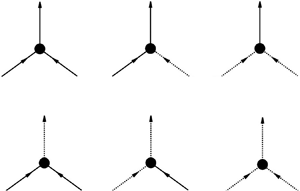Article contents
Generalised quasilinear approximations of turbulent channel flow. Part 1. Streamwise nonlinear energy transfer
Published online by Cambridge University Press: 15 February 2022
Abstract

A generalised quasilinear (GQL) approximation (Marston et al., Phys. Rev. Lett., vol. 116, 2016, 104502) is applied to turbulent channel flow at  $Re_\tau \simeq 1700$ (
$Re_\tau \simeq 1700$ ( $Re_\tau$ is the friction Reynolds number), with emphasis on the energy transfer in the streamwise wavenumber space. The flow is decomposed into low- and high-streamwise-wavenumber groups, the former of which is solved by considering the full nonlinear equations whereas the latter is obtained from the linearised equations around the former. The performance of the GQL approximation is subsequently compared with that of a QL model (Thomas et al., Phys. Fluids, vol. 26, 2014, 105112), in which the low-wavenumber group only contains zero streamwise wavenumber. It is found that the QL model exhibits a considerably reduced multi-scale behaviour at the given moderately high Reynolds number. This is improved significantly by the GQL approximation which incorporates only a few more streamwise Fourier modes into the low-wavenumber group, and it reasonably well recovers the distance-from-the-wall scaling in the turbulence statistics and spectra. Finally, it is proposed that the energy transfer from the low- to the high-wavenumber group in the GQL approximation, referred to as the ‘scattering’ mechanism, depends on the neutrally stable leading Lyapunov spectrum of the linearised equations for the high-wavenumber group. In particular, it is shown that if the threshold wavenumber distinguishing the two groups is sufficiently high, the scattering mechanism can be completely absent due to the linear nature of the equations for the high-wavenumber group.
$Re_\tau$ is the friction Reynolds number), with emphasis on the energy transfer in the streamwise wavenumber space. The flow is decomposed into low- and high-streamwise-wavenumber groups, the former of which is solved by considering the full nonlinear equations whereas the latter is obtained from the linearised equations around the former. The performance of the GQL approximation is subsequently compared with that of a QL model (Thomas et al., Phys. Fluids, vol. 26, 2014, 105112), in which the low-wavenumber group only contains zero streamwise wavenumber. It is found that the QL model exhibits a considerably reduced multi-scale behaviour at the given moderately high Reynolds number. This is improved significantly by the GQL approximation which incorporates only a few more streamwise Fourier modes into the low-wavenumber group, and it reasonably well recovers the distance-from-the-wall scaling in the turbulence statistics and spectra. Finally, it is proposed that the energy transfer from the low- to the high-wavenumber group in the GQL approximation, referred to as the ‘scattering’ mechanism, depends on the neutrally stable leading Lyapunov spectrum of the linearised equations for the high-wavenumber group. In particular, it is shown that if the threshold wavenumber distinguishing the two groups is sufficiently high, the scattering mechanism can be completely absent due to the linear nature of the equations for the high-wavenumber group.
JFM classification
- Type
- JFM Papers
- Information
- Copyright
- © The Author(s), 2022. Published by Cambridge University Press
References
REFERENCES
- 11
- Cited by





